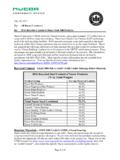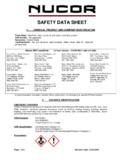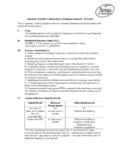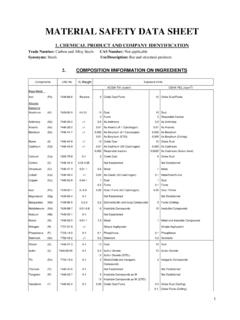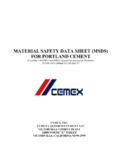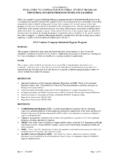Transcription of SAFETY DATA SHEET - ★ Nucor Corporation
1 Page 1 of 10 Revision Date: 3/5/2018 SAFETY DATA PRODUCT AND COMPANY IDENTIFICATIONT rade Name: SHEET Steel CAS Number: Not applicable Synonyms: Hot Band, Cold Rolled, Hot Roll Pickled, Galvanized, Galvanneal Use/Description: Steel for thin gauge products and SHEET steel for Castrip Company Identification: 24 Hour Contact CHEMTREC 1-800-424-9300 Nucor Steel Arkansas 7301 E. County Road 142 Blytheville, AR 72315 SAFETY Officer [8:00 am 5:00 pm]: 1-(870) 762-2100 Nucor Castrip Arkansas, LLC 6061 E. State Highway 18 Blytheville, Arkansas 72315 SAFETY Officer [8:00 am 5:00 pm]: 1-(870) 762-5500 Nucor Steel Berkeley 1455 Hagan Avenue Huger, SC 29450 SAFETY Officer [8:00 am 5:00 pm]: 1-(843) 336-6000 Nucor Steel Decatur, LLC 4301 Iverson Boulevard Trinity, AL 35673 SAFETY Officer [8:00 am 5:00 pm]: 1-(256) 301-3500 Nucor Steel Indiana 4537 South Nucor Road Crawfordsville, IN 47933 SAFETY Officer [8:00 am 5:00 pm]: 1-(765) 364-1323 Nucor Castrip Indiana 4537 South Nucor Road Crawfordsville, IN 47933 SAFETY Officer [8:00 am 5:00 pm]: 1-(765) 364-1323 Nucor Steel Gallatin 4831 Hwy 42 West Ghent, KY 41045 SAFETY Officer [8:00 am 5:00 pm]: 1-(859) 567-3100 Nucor Steel Tuscaloosa, Inc.
2 1700 Holt Road, NE Tuscaloosa, Alabama 35404 SAFETY Officer [8:00 am 5:00 pm]: 1-(205) 556-1310 For general product information, contact facility as listed above. For emergencies, use the 24 Hour Contact. IDENTIFICATIONEMERGENCY OVERVIEW STEEL PRODUCTS AS SOLD BY Nucor ARE NOT HAZARDOUS PER osha GHS 29 CFR 1910, 1915, 1926. However, individual customer processes, (such as welding, sawing, brazing, grinding, abrasive blasting, and machining) may result in the formation of fumes, dust (combustible or otherwise), and/or particulate that may present the following hazards: SHEET Steel Page 2 of 10 Revision Date: 3/5/2018 osha Hazards: Carcinogen Skin Sensitizer Target Organ Effect Lungs GHS Classification: Carcinogenicity (Category 2) Skin Sensitization (Category 1) Specific Target Organ Toxicity-Repeated Exposure (Category 1) Pictogram(s): Signal Word: Danger Hazard Statement(s) H317: Dust/fumes may cause an allergic skin reaction.
3 H351: Dust/fumes suspected of causing cancer via inhalation. H372: Inhalation of dust/fumes causes damage to respiratory tract through prolonged or repeated exposure Precautionary Statement(s) P202: Do not handle until all SAFETY precautions have been read and understood. P261: Avoid breathing dust/fumes. P281: Use personal protective equipment as required. P308+P313: If exposed or concerned: Get medical advice/attention. Potential Health Effects Eye Contact Dusts or particulates may cause mechanical irritation including pain, tearing, and redness. Scratching of the cornea can occur if eye is rubbed. Fumes may be irritating. Contact with the heated material may cause thermal burns. Skin Contact Dusts or particulates may cause mechanical irritation due to abrasion. Coated steel may cause skin irritation in sensitive individuals (see Section 16 for additional information.) Some components in this product are capable of causing an allergic reaction, possibly resulting in burning, itching and skin eruptions.
4 Contact with heated material may cause thermal burns. Inhalation Dusts may cause irritation of the nose, throat, and lungs. Excessive inhalation of metallic fumes and dusts may result in metal fume fever, an influenza-like illness. It is characterized by a sweet or metallic taste in the mouth, accompanied by dryness and irritation of the throat, cough, shortness of breath, pulmonary edema, general malaise, weakness, fatigue, muscle and joint pains, blurred vision, fever and chills. Typical symptoms last from 12 to 48 hours. Ingestion Not expected to be acutely toxic via ingestion based on the physical and chemical properties of the product. Swallowing of excessive amounts of the dust may cause irritation, nausea, and diarrhea. Potential Fire and Explosion Hazards Under normal conditions, steel products do not present fire or explosion hazards, and dust generated by handling steel products is oxidized and not combustible. Processing of steel product by some individual customers may produce potentially combustible dust that may represent a fire or explosion hazard.
5 SHEET Steel Page 3 of 10 Revision Date: 3/5/2018 Chronic or Special Toxic Effects Repeated exposure to fine dusts may inflame the nasal mucosa and cause changes to the lung. In addition, a red-brown pigmentation of the eye and/or skin may occur. Welding fumes have been associated with adverse health effects. Contains components that may cause cancer or reproductive effects. The following components are listed by NTP, osha , or IARC as carcinogens: Nickel, chromium (hexavalent), cobalt, lead, cadmium, antimony (trioxide), arsenic, and beryllium. See Section 11, for additional, specific information on effects noted above. Target Organs Overexposure to specific components of this product that are generated in dusts or fumes may cause adverse effects to the following organs or systems: eyes, skin, liver, kidney, central nervous system, cardiovascular system, respiratory system. Medical Conditions Aggravated by Exposure Diseases of the skin such as eczema may be aggravated by exposure.
6 Also, disorders of the respiratory system including asthma, bronchitis, and emphysema. Long-term inhalation exposure to agents that cause pneumoconiosis ( dust) may act synergistically with inhalation of oxide fumes or dusts of this product. ON INGREDIENTSC omponents CAS No. % Weight Exposure Limits Base Metal: Iron Alloying Elements (Fe) 7439-89-6 Balance ACGIH TLV (mg/m3) osha PEL (mg/m3) 5 Oxide Dust/Fume 10 Oxide Dust/Fume Aluminum (Al) 7429-90-5 10 5 Dust Fume 15 5 Dust Respirable fraction Antimony (Sb) 7440-36-0 < As Antimony As Antimony Arsenic (As) 7440-38-2 < As Arsenic (A1 Carcinogen) As Arsenic Beryllium (Be) 7440-41-7 < As Beryllium (A1 Carcinogen) As Beryllium (STEL) As Beryllium As Beryllium (Ceiling) Boron (B) 7440-42-8 < 10 Oxide Dust 15 Oxide Dust Cadmium (Cd) 7440-43-9 < As Cadmium (A2 Carcinogen) Respirable fraction As Cadmium As Cadmium (Action Level) Calcium (Ca) 1305-78-8 < 2 Oxide Dust 5 Oxide Dust Carbon (C) 7440-44-0 < Not Established Not Established Chromium (Cr) 7440-47-3 Metal 1 Metal Cobalt (Co) 7440-48-4 < As Cobalt (A3 Carcinogen) Metal/Dust/Fume Copper (Cu) 7440-50-8 < 1 Dust Fume 1 Dust Fume Lead (Pb) 7439-92-1 Dust / Fume (A3 Carcinogen)
7 Dust / Fume Magnesium (Mg) 7439-95-4 < Not Established Not Established Manganese (Mn) 7439-96-5 < Elemental Mn and Inorg Compounds 5 Fume (Ceiling) SHEET Steel Page 4 of 10 Revision Date: 3/5/2018 Components CAS No. % Weight Exposure Limits ACGIH TLV (mg/m3) osha PEL (mg/m3) Molybdenum (Mo) 7439-98-7 < 10 Insoluble Compounds 15 Insoluble Compounds Niobium (Nb) 7440-03-1 < Not Established Nickel (Ni) 7440-02-0 Metal 1 Metal and Insoluble Compounds Nitrogen (N) 7727-37-9 < Simple Asphyxiant Simple Asphyxiant Phosphorus (P) 7723-14-0 < Phosphorus Phosphorus Selenium (Se) 7782-49-2 < Selenium Selenium Silicon (Si) 7440-21-3 Dust 15 Dust Sulfur (S) 7446-09-05 < 13 Sulfur Dioxide Sulfur Dioxide (STEL) 13 Sulfur Dioxide Tin (Sn) 7440-31-5 < 2 Metal, Oxide and Inorganic Compounds 2 Inorganic Compounds Titanium (Ti) 7440-32-6 < Not Established Not Established Tungsten (W) 7440-33-7 < 5 10 Insoluble Compounds as W Insoluble Compounds as W (STEL) Not Established Vanadium (V) 7440-62-2 < Oxide Dust/Fume Oxide Dust (Ceiling) Oxide Fume (Ceiling) Zinc (Zn) 7440-66-6 10 5 10 Oxide Dust Oxide Fume Oxide Fume (STEL)
8 5 10 Oxide Fume Oxide Dust Coatings and Finishing Treatments: Hydrochloric Acid (HCl) 7647-01-0 <3 Petroleum, Natural or Synthetic oils Mixture < 5 Mist 5 Mist Anhydrous Potassium Hydroxide 1310-58-3 < 2 Ceiling 2 Ceiling Glycine,nn-1,2- ethanediylbis 60-00-4 < Polyalkylene glycol Mixture < Sodium nitrite 7632-00-0 < Zinc (galvanized/galvanneal) 7440-66-6 - 10 10 5 10 Oxide Dust Oxide Fume Oxide Fume (STEL) 5 10 Oxide Fume Oxide Dust NOTE: No permissible exposure limits (PEL) or threshold limit values (TLV) exist for steel over all. The above listing is a summary of elements used in normal Nucor Steel Products. Various grades of steel will contain different combinations of these elements and/or trace materials. Exact specifications for specific products may be available upon request. SHEET Steel Page 5 of 10 Revision Date: 3/5/2018 AID MEASURESEye Contact- In case of overexposure to dusts or fumes, immediately flush eyes with plenty of water for at least 15 minutes occasionally lifting the eye lids.
9 Get medical attention if irritation persists. Thermal burns should be treated as medical emergencies. Skin Contact - In case of overexposure to dusts or particulates, wash with soap and plenty of water. Get medical attention if irritation develops or persists. If thermal burn occurs, flush area with cold water and get immediate medical attention. Inhalation - In case of overexposure to dusts or fumes, remove to fresh air. Get immediate medical attention if symptoms described in this SDS develop. Ingestion - Not considered an ingestion hazard. However, if excessive amounts of dust or particulates are swallowed, treat symptomatically and supportively. Get medical attention. Notes to Physician - Inhalation of metal fume or metal oxides may produce an acute febrile state, with cough, chills, weakness, and general malaise, nausea, vomiting, muscle cramps, and remarkable leukocytosis. Treatment is symptomatic, and condition is self limited in 24-48 hours.
10 Chronic exposure to dusts may result in pneumoconiosis of mixed type. FIGHTING MEASURESF lash Point (Method) - Not applicable Flammable Limits (% volume in air) - Not applicable Auto ignition Temperature - Not applicable Extinguishing Media - For molten metal, use dry powder or sand. For steel dust use or dry sand, water, foam, argon or nitrogen. Special Fire Fighting Procedures - Do not use water on molten metal. Do not use Carbon Dioxide (CO2). Firefighters should not enter confined spaces without wearing NIOSH/MSHA approved positive pressure breathing apparatus (SCBA) with full face mask and full protective equipment. Unusual Fire or Explosion Hazards - Steel products do not present fire or explosion hazards under normal conditions. Any non-oxidized fine metal particles/ dust generated by grinding, sawing, abrasive blasting, or individual customer processes may produce materials that the customer should test for combustibility and other hazards in accordance with applicable regulations.
